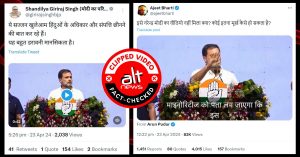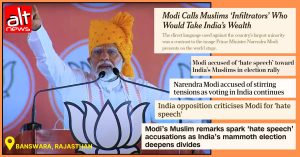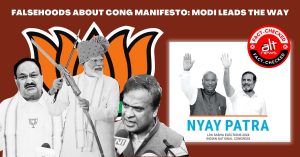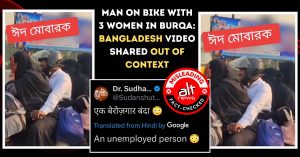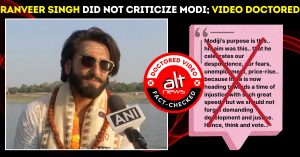The raging controversy over the movie ‘Padmaavat’ and the subsequent violence that erupted across states was the top story for prime time television, and perhaps rightly so. Breakdown of law and order is a serious challenge, and the media ought to do its part on highlighting the dangers of unchecked aggression and vandalism which poses a threat to the legitimacy and authority of the state. In their coverage of this news, the organisations and groups like ‘Karni Sena’ have been repeatedly and incessantly described as the ‘fringe’. The ‘fringe’ has now become a ubiquitous threat, yet it remains the fringe for sections of mainstream media.
Fringe is defined as ‘the outer, marginal, or extreme part of an area, group, or sphere of activity’. In this particular context, the term refers to the extremist elements of organisations that are conservative in their outlook and approach. The word ‘fringe’ is the go-to word for television news channels whenever there is a report of arson and violence by some of these groups. The very definition suggests that these elements are ‘outer’ or ‘marginal’ to ‘an area, group, or sphere of activity’, thus not representing the mainstream. Some groups and organisations that have been described as fringe by TV channels are Karni Sena, Hindu Yuva Vahini, Hindu Sena, Hindu Makkal Katchi etc. Apart from these, other groups and organisations belonging to different religious denominations too have been described as fringe.
So, are these groups really ‘fringe’ or do they exercise greater influence? Alt News looked at the history of these groups and their political affiliations.
1. Rajput Karni Sena
Karni sena is the latest fringe outfit in the country, according to mainstream media. But is it really a fringe organisation or are the members of the group associated with the ruling party? CNN News18 referred to Karni sena as fringe.
[OPINION] Is this the #NewIndia that we want to showcase to the rest of the world? CNN-News18’s @Zakka_Jacob pens an open letter to ‘Fringe AKA Karni Sena’ #IWillSeePadmaavat#PadmaavatRow#Padmaavathttps://t.co/dR62VwdIti
— News18 (@CNNnews18) January 25, 2018
Lokendra Singh Kalvi, founder president of Rajput Karni Sena who is again portrayed as a fringe leader had been a member of the BJP. Republic TV reported the story designating Kalvi as Karni Sena chief, with the hashtag #IndiavsFringe.
#IndiaVsFringe | WATCH: Arnab confronts Karni Sena chief Lokendra Kalvi over Padmaavat violence. Watch the full interview here – https://t.co/4pqlzr1ONM pic.twitter.com/FTTA760zTN
— Republic (@republic) January 24, 2018
Kalvi was the Lok Sabha candidate for the BJP from Barmer, which he lost. In 2008, he joined the Congress, but was reinducted into the BJP in 2014 in what was called a ‘masterstroke’ by Rajasthan CM. Vasundhara Raje. Alt News had published a detailed report which can be read here. Not once did TV channels refer to his ties with the BJP.
Republic TV called Karni sena leader Suraj Pal Amu as a fringe leader.
#NetasBackFringe | WATCH: Aisi baat karne se pehle main logo ka muh band kar deta hoon: Suraj Pal Amu threatens Republic TV for its coverage of #Padmaavathttps://t.co/yHW2jt8wNV
— Republic (@republic) January 25, 2018
It is worthwhile to note that Amu was the chief media co-ordinator of the Haryana unit of BJP not so long ago. He resigned from the post after the uproar over his controversial comment wherein he had declared a bounty on Padmaavat actress Deepika Padukone and director Sanjay Leela Bhansali. Amu was predictably disowned by the BJP, and Amu himself stated that he had made the remarks in his ‘personal capacity’. Amu had joined BJP in 1984.
2. Hindu Yuva Vahini
#BREAKING: Fringe strikes in U.P, youth abused and thrashed as he was accused of ‘love jehad’, cops remain mute spectators pic.twitter.com/OTRjdCnm0i
— TIMES NOW (@TimesNow) January 14, 2018
The tweet accompanying the video clip posted above says ”Fringe strikes in U.P, youth abused and thrashed as he was accused of ‘love jehad”. What the tweet fails to mention is recited by the anchor, who says members of Hindu Yuva Vahini were arrested by U.P police for assaulting a youth on the pretext of ‘love jehad’. Hindu Yuva Vahini members have been called ‘fringe’ by Times Now. What is Hindu Yuva Vahini? It is a militia of Hindu youth which was founded by the current U.P CM Yogi Adityanath in 2002. The organisation has been accused of rioting, arson, abduction and caste violence since its inception and has been frequently in the news over issues such as ‘Love Jihad’ and ‘Ghar Wapasi’.
Fringe group Hindu Yuva Vahini strikes again in UP’s Bulandshahr; Muslim man beaten to death over kidnapping of Hindu girl #HateVahini pic.twitter.com/ghhxVpPuhL
— TIMES NOW (@TimesNow) May 3, 2017
It defies logic how an organisation established by the sitting Chief Minister of U.P and fully active in the state be described as fringe.
3. Bajrang Dal
The Bajrang Dal too has been described as a fringe organisation. In 2016, Times Now broadcast a story on a ‘training camp’ conducted by the organisation, ostensibly for the purpose of ‘defending the nation from anti-national forces’. Bajrang Dal was described as the ‘Fringe army’.
Are Bajrang Dal training camps deliberate attempt to polarise society in UP ahead of assembly elections in 2017? Join the debate #FringeArmy
— TIMES NOW (@TimesNow) May 24, 2016
The Bajrang Dal is one of the key wings of the larger Sangh parivar. It is the youth wing of the Vishwa Hindu Parishad (VHP). Founded in 1984, the organisation has repeatedly been embroiled in acts of communal violence and hatred. A key member of the Bajrang Dal who went on to join the BJP is Vinay Katiyar, who is now a Rajya Sabha member. Yet, both these organisations are fringe for TV news channels.
Fringe groups VHP & Bajrang Dal write to Bengaluru Police seeking cancellation of Shafqat Amanat Ali concert in Bengaluru pic.twitter.com/wDedzsT47u
— TIMES NOW (@TimesNow) September 28, 2016
Many of these organisations have simply mushroomed out of nowhere over the years. There is a broad ideological affinity among them, representing majoritarian assertion and masculinity. However, in the event of violence, they are conveniently disowned by the larger parivar.
The Dadri incident too where Muhammad Akhlaq had been lynched over rumours that he ate beef was reported as the work of the fringe.
It’s time to take a stand, because India can’t be controlled by the fringe #FlashpointDadri pic.twitter.com/tzgvM8uXiL
— TIMES NOW (@TimesNow) October 7, 2015
All pretence though was thrown to the wind when in a public act of veneration, MoS Culture and Environment, Mahesh Sharma draped the killer of Mohammad Akhlaq in the tricolour at Dadri. RSS leader Manmohan Vaidya had said that the Dadri incident was the handiwork of fringe organisations and that the Sangh should not be dragged into it. It is worth noting that one of the accused in the Akhlaq lynching case is the son of a local BJP leader.
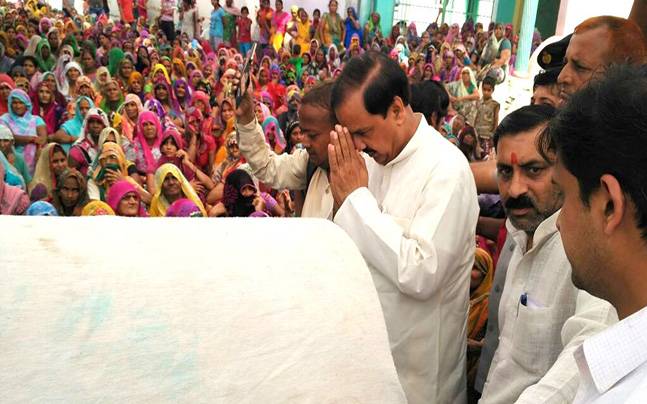
BJP MLA from U.P Sangeet Som, who is an accused in the Muzaffarnagar riots of 2013 and has been instrumental in keeping the communal pot boiling in the Western U.P region, and Sadhvi Niranjan Jyoti who is a union minister have been dismissed as fringe by spokespersons and leaders of the BJP, despite being prominent members of party and government.
Then, there are BJP leaders like Raja Singh, MLA from Goshamal constituency in Hyderabad who are notorious for making inflammatory statements provoking hatred against minorities and Dalits. Raja has on numerous occasions made blatantly communal and casteist statements. He had justified the violence against Dalits in Una, Gujarat and more recently warned of setting cinema halls on fire over the release of ‘Padmaavat’. Raja continues to be a lawmaker.
Considering these close links between members of the ruling party and members of these so-called fringe organisations, how has the mainstream media addressed this issue? The coverage by television news channels draws a clear distinction between these organisations and the state. Sample some of the questions that have been asked by TV news channels:
‘Are state governments mute spectators to fringe vandalism?’
Are vote bank considerations forcing State govts to give free run to fringe?
‘Why are states soft on fringe despite violent threats?’
Were these Chief Ministers handed a mandate by the people just to allow fringe a free run?
By allowing fringe a free run, havent states totally ignored the Supreme Court directives?
All these questions draw a clear distinction between such groups that take the law in their hands, and State governments and politicians from the ruling dispensation. The basic assertion here is that such organisations are antithetical to the state. Even the hashtags used by the channels such as #IndiavsFringe and #FringevsPadmaavat, and the use of titles like ‘Minority Mob vs Majority Might’ betray a deliberate attempt to portray a dichotomy. Reportage by mainstream news organisations on this issue is cautious at best and disingenuous at worst, steering clear of asking the central question- on the linkage between these ‘fringe’ groups and the ruling party when enough material is available in the public domain to suggest such proximity, and how the state in such a case is expected to uphold the rule of law and show the will to act.
Independent journalism that speaks truth to power and is free of corporate and political control is possible only when people start contributing towards the same. Please consider donating towards this endeavour to fight fake news and misinformation.
